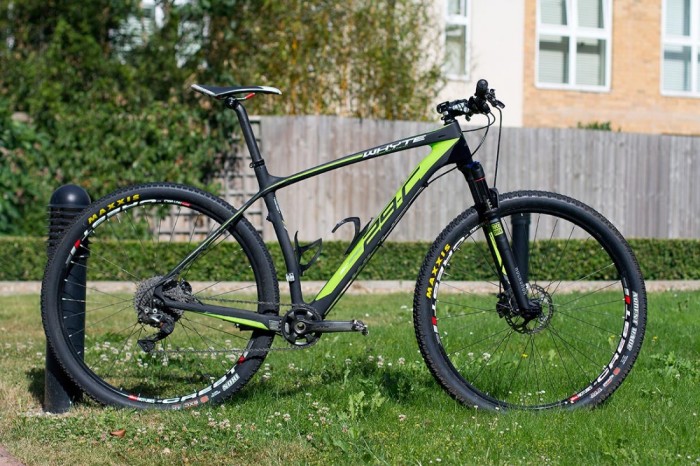I’m getting on a plane to Mongolia next month and I’m taking Whyte’s 29-C with me.
I’m approaching the Mongolia Bike Challenge with a heady mix of apprehension and excitement. The race is 856km. Based on some (rough) guess work, I’ll spend upwards of 40 hours of my time in Mongolia on board the 29-C.
When we featured this bike in April I mentioned I didn’t know a lot about Whyte. But we knew what it would be lining up to do.
The incredible scenery in Mongolia. Photo: Margus Riga
Whyte’s secret weapon: Geometry
The geometry of the 29-C was a key element in my decision to buy the frame.
Since taking delivery of it, I’ve had the good fortune to meet the men who designed it. They admitted to me that in a crowded bike market (100+ brands in the UK alone, by their reckoning) standing out can be difficult. Whyte’s response has been to focus on geometry as a key feature of their frames.
The Elk that adorns Whyte’s frames. Photo: Richie Tyler
Advice led me to select a large – the largest offered. It’s turned out to be an excellent decision. A long wheelbase (1145mm) provides a forgiving ride.
The length is matched with slack head angle. It’s for this reason I opted for Pro’s Tharsis 740mm handlebars. The extra width has resulted in great handling, even at slower speeds when things are at their twitchiest. Whyte offer their bikes with wide bars and short stems for this very reason.
RockShox’s Reba is a great match for the 29C. Not just because of the matching green livery, but the ride quality too. And thankfully for a remote stage race like the Mongolia Bike Challenge, it doesn’t use anything too proprietary like the the RS-1 – or a SID World Cup with a carbon crown and steerer. The fork mounted lock out is also one less cable to worry about.
Rock Shox Reba, colour-coded to the Whyte frame. Photo: Richie Tyler
I know this isn’t a very scientific way of assessing a bike, but it’s a good way of summing up my experience of this bike: It’s a lot of fun to ride down hill.
Cruising on carbon
What goes down will almost certainly go up again. With 13,400+ metres of climbing and long stretches of double-track in Mongolia, lugging rear suspension was a luxury I opted to forgo.
The carbon fibre frame helps keep the weight down while also providing a stiff platform for climbing. The beefy bottom bracket keeps power heading in the right direction, while wishbone seatstays have done a great job absorbing some of the higher frequency vibrations. Being British, the svelte seat stays provide a lot of mud clearance, but their shape allows for heel clearance too – no matter how ragged my pedalling will get on long days.
Thin seatstays get a wishbone for compliance. Photo: Richie Tyler
It certainly “does what it says on the tin”. It’s light and stiff, leaving me as the weak link in upwards acceleration.
Internal cable routing for the rear derailleur keeps it tucked out of harms way. Running a single chainring setup, I only have the one shift cable to worry about (a relief).
Neat cable routing is a feature of Whyte’s bikes. Photo: Richie Tyler
Shimano XTR
No bones about it, I’m being spoilt riding with Shimano’s top-of-the-line group. You can read about the performance of Shimano’s XTR in the long-term test I published earlier this week.
From my experience over the past few months, I’m heading to Mongolia with one of the smoothest, most reliable groupsets on the market. The only change I may make is to add a 34 tooth chainring, rather than the 32 tooth option I’ve been using thus far; I’ve rarely dipped down to the massive 40-tooth ring on the rear.
The XTR M9000 rear derailleur provides crisp shifting across the 11-speed cassette. Photo: Richie Tyler
Hoop dreams
The Stan’s NoTubes Crest 29-inch rims have been brilliant. They’re laced in to Stan’s 3.30 hubs (that company also taking care of tubeless duties). I could have saved some extra weight here, but It would be at considerable expense to move to a carbon rimmed wheel. The Crest wheel set is proving reliable, and that’s my biggest concern.
I’ve opted for Maxxis’ Ikon (with reinforced sidewalls) on the rear and Ardent Race up front. Running them out on a combination of trail rides and a brief spell of XC racing, they’re a great choice. I may swap out for Ikon’s front-and-rear come race time, just to provide some additional protection from sidewall-related incidents – and for slightly faster rolling.
There’s a 40+ hour week in store on the 29-C. And I can’t wait. Even if you’re planning on shorter rides, you’ll get a hell of a lot of fun out of it.
You can find out more details on the Whyte range on their website.

